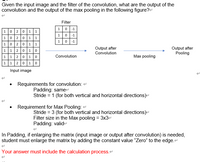
Database System Concepts
7th Edition
ISBN: 9780078022159
Author: Abraham Silberschatz Professor, Henry F. Korth, S. Sudarshan
Publisher: McGraw-Hill Education
expand_more
expand_more
format_list_bulleted
Question
thumb_up100%

Transcribed Image Text:Given the input image and the filter of the convolution, what are the output of the
convolution and the output of the max pooling in the following figure?e
Filter
10 -1
101
10 -1
102 011
|102 01 1
102 011
|1 1 2 01 o
|112010
112 010
Output after
Convolution
Output after
Pooling
Convolution
Маx рooling
Input image
Requirements for convolution: e
Padding: samee
Stride = 1 (for both vertical and horizontal directions)-
• Requirement for Max Pooling: e
Stride = 3 (for both vertical and horizontal directions)-
Filter size in the Max pooling = 3x3-
Padding: valide
In Padding, if enlarging the matrix (input image or output after convolution) is needed,
student must enlarge the matrix by adding the constant value "Zero" to the edge.e
Your answer must include the calculation process.e
Expert Solution
This question has been solved!
Explore an expertly crafted, step-by-step solution for a thorough understanding of key concepts.
This is a popular solution
Trending nowThis is a popular solution!
Step by stepSolved in 2 steps with 2 images

Knowledge Booster
Learn more about
Need a deep-dive on the concept behind this application? Look no further. Learn more about this topic, computer-science and related others by exploring similar questions and additional content below.Similar questions
- I created a DCM from Euler angle sequence 1-2-3. Then I found the Principal Rotation Parameters from the DCM. Then I used the Principal Rotation Parameters to find the DCM again. But I produced a different DCM both times. Can you help me fix the MATLAB code, so I produce the same DCM both times? EA = [pi/3; -pi/4; -pi/6];EA123toDCM = EA123DCM(EA) [theta, lambda] = DCMtoPRP(EA123toDCM) PRPtoDCM = PRP2DCM(theta, lambda) function [R] = EA123DCM(EA) theta1 = EA(1,1); theta2 = EA(2,1); theta3 = EA(3,1); R1 = @(a)[1 0 0 ; 0 cos(a) sin(a); 0 -sin(a) cos(a)]; R2 = @(a)[cos(a) 0 -sin(a) ; 0 1 0 ; sin(a) 0 cos(a)]; R3 = @(a)[ cos(a) sin(a) 0; -sin(a) cos(a) 0; 0 0 1]; R = R3(theta1)*R2(theta2)*R1(theta3); end function [theta, lambda] = DCMtoPRP(EA123toDCM) theta = acos((1/2)*(trace(EA123toDCM)) - 1); lambda =…arrow_forwardAttach Matlab code and output screenshot.arrow_forwardUsing Matlab computer software, write the code to plot the surface z = e. %3D After writing the code, describe this surface. You can use a set of values between -5 to 5 for your operations.arrow_forward
- Write a MATLAB program to find the autocorrelation of the signal given below but you have to use the conv() function to find the autocorrelation. The use of the corr() function will lead to the rejection of the assignment. Signal: x (n) = {0,1,4,–3} %3Darrow_forwardFind and draw the excitation tablearrow_forwardCalculate the probability that a harmonic oscillator in the first excited state will be found in the classically forbidden region. (Hint: you will need to numerically integrate using MATLAB). How does your result compare to the result for the ground vibrational state (you don't need to calculate this number because you can find it in the textbook)? How do these probabilities depend on the strength of the bond, te the force constant, kf?arrow_forward
- Describe the procedure for Monte Carlo localization using a particle filter.arrow_forwardDesign a 2-D Laplacian of Gaussian (LoG) 1x5 filter with sigma = 2arrow_forwardMatlab: Create a linearly polarized light with its polarization along the X axis. (ii) Specify the polarization angle of the linear polarizer with respect to the X axis. (iii) Calculate the fields EX(t) and EY(t) after the polarizer. (iv) Similar with (a) (iii), plot the output vectorial fields ( EX(t), EY(t) after the polarizer) and the input vectorial fields (EX(t), EY(t) before the polarizer) in ONE time-lapse plot.arrow_forward
arrow_back_ios
arrow_forward_ios
Recommended textbooks for you
 Database System ConceptsComputer ScienceISBN:9780078022159Author:Abraham Silberschatz Professor, Henry F. Korth, S. SudarshanPublisher:McGraw-Hill Education
Database System ConceptsComputer ScienceISBN:9780078022159Author:Abraham Silberschatz Professor, Henry F. Korth, S. SudarshanPublisher:McGraw-Hill Education Starting Out with Python (4th Edition)Computer ScienceISBN:9780134444321Author:Tony GaddisPublisher:PEARSON
Starting Out with Python (4th Edition)Computer ScienceISBN:9780134444321Author:Tony GaddisPublisher:PEARSON Digital Fundamentals (11th Edition)Computer ScienceISBN:9780132737968Author:Thomas L. FloydPublisher:PEARSON
Digital Fundamentals (11th Edition)Computer ScienceISBN:9780132737968Author:Thomas L. FloydPublisher:PEARSON C How to Program (8th Edition)Computer ScienceISBN:9780133976892Author:Paul J. Deitel, Harvey DeitelPublisher:PEARSON
C How to Program (8th Edition)Computer ScienceISBN:9780133976892Author:Paul J. Deitel, Harvey DeitelPublisher:PEARSON Database Systems: Design, Implementation, & Manag...Computer ScienceISBN:9781337627900Author:Carlos Coronel, Steven MorrisPublisher:Cengage Learning
Database Systems: Design, Implementation, & Manag...Computer ScienceISBN:9781337627900Author:Carlos Coronel, Steven MorrisPublisher:Cengage Learning Programmable Logic ControllersComputer ScienceISBN:9780073373843Author:Frank D. PetruzellaPublisher:McGraw-Hill Education
Programmable Logic ControllersComputer ScienceISBN:9780073373843Author:Frank D. PetruzellaPublisher:McGraw-Hill Education

Database System Concepts
Computer Science
ISBN:9780078022159
Author:Abraham Silberschatz Professor, Henry F. Korth, S. Sudarshan
Publisher:McGraw-Hill Education

Starting Out with Python (4th Edition)
Computer Science
ISBN:9780134444321
Author:Tony Gaddis
Publisher:PEARSON

Digital Fundamentals (11th Edition)
Computer Science
ISBN:9780132737968
Author:Thomas L. Floyd
Publisher:PEARSON

C How to Program (8th Edition)
Computer Science
ISBN:9780133976892
Author:Paul J. Deitel, Harvey Deitel
Publisher:PEARSON

Database Systems: Design, Implementation, & Manag...
Computer Science
ISBN:9781337627900
Author:Carlos Coronel, Steven Morris
Publisher:Cengage Learning

Programmable Logic Controllers
Computer Science
ISBN:9780073373843
Author:Frank D. Petruzella
Publisher:McGraw-Hill Education